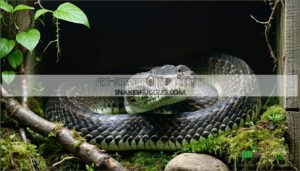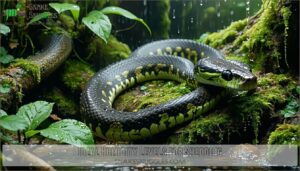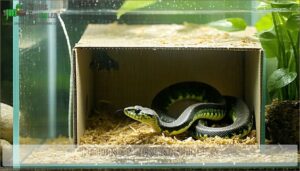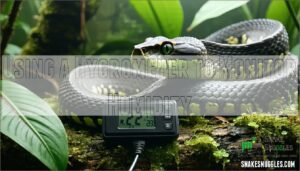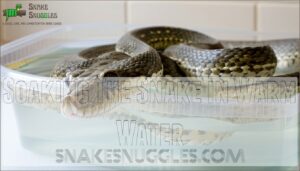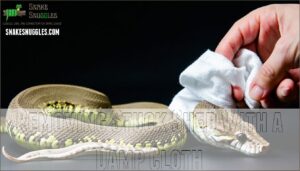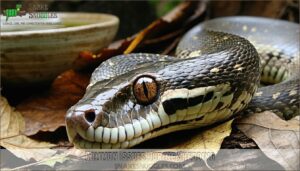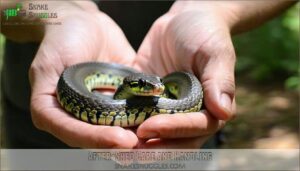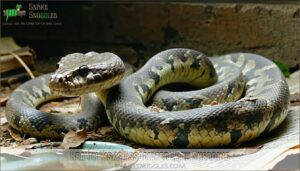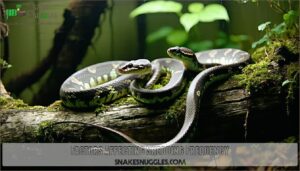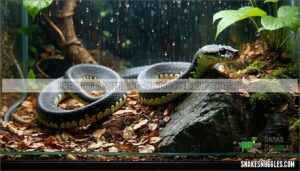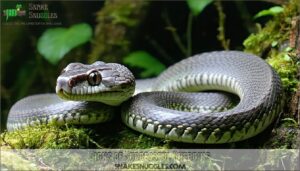This site is supported by our readers. We may earn a commission, at no cost to you, if you purchase through links.
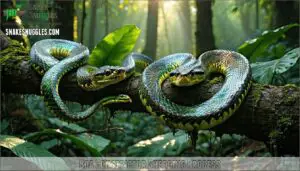
You’ll notice your snake getting less active as it prepares to shed its entire skin in one piece, like taking off a sock.
During this time, you’ll need to increase humidity to 60-70% and provide rough surfaces for rubbing, which makes a difference between a smooth shed and potentially painful complications.
The actual shedding takes 7-14 days from start to finish, and proper humidity control is crucial, as it’s a vulnerable time – they’re not in the mood for socializing, so don’t handle your snake.
Table Of Contents
- Key Takeaways
- Boa Constrictor Shedding Process
- Pre-Shedding Preparation
- Humidity Control During Shedding
- Shedding Assistance and Troubleshooting
- After-Shed Care and Handling
- Health Risks Associated With Shedding
- Factors Affecting Shedding Frequency
- Creating a Shedding-Conducive Environment
- Signs of Successful Shedding
- Frequently Asked Questions (FAQs)
- How long does it take for a boa constrictor to shed?
- How do I tell if my boa is shedding?
- What are the stages of snake shedding?
- Why is my boa taking so long to shed?
- What happens when a boa shed comes off?
- How to care for a boa constrictor?
- What is boa constrictor husbandry?
- How do I create a boa constrictor habitat?
- How often do boas shed their skin?
- What causes cloudy eyes during shedding?
- Conclusion
Key Takeaways
- You’ll notice clear signs before shedding, including cloudy eyes, dull skin, decreased appetite, and increased hiding behavior, which typically begin 7-10 days before the actual shed occurs.
- You need to maintain 80-90% humidity during shedding by misting the enclosure, providing a humid hide box, and using moisture-retaining substrates like coconut fiber or cypress mulch.
- Don’t handle your boa during shedding as it’s a vulnerable time, and wait at least 24 hours after completion before resuming gentle handling to reduce stress.
- You can help with stuck shed by soaking your snake in warm water (85-90°F) for 15-20 minutes and gently removing remaining pieces with a damp cloth, moving in a head-to-tail direction.
Boa Constrictor Shedding Process
Shedding is a natural process that helps your boa constrictor grow and maintain healthy skin.
By understanding the signs, timing, and factors influencing shedding, you can guarantee your snake’s skin comes off cleanly every time, which is crucial for its overall health.
Signs of Impending Shedding
Every boa constrictor shows telltale signs before shedding begins.
Recognizing these signals helps you provide proper care during this vulnerable time.
Watch for these key pre-shedding indicators:
- Cloudy eyes – A milky blue-white appearance signals the "blue phase" about 7-10 days before shedding
- Dull skin – Colors fade and patterns become less distinct as old skin loosens
- Appetite loss – Most boas stop eating completely during pre-shed periods
- Increased hiding behavior – Your snake seeks security while its vision is impaired
You’ll also notice decreased activity and occasional irritability as your boa prepares for this natural process.
Understanding these preshedding behaviors guarantees you’ll know exactly when to adjust humidity levels.
Shedding Frequency and Duration
Shedding frequency in boa constrictors isn’t random—age, diet, and growth rate steer the cycle.
Younger boas grow quickly, shedding every 4-8 weeks, while adults shed every 2-3 months.
High protein diets and warmer temperatures speed shedding intervals, but stability guarantees healthy cycles, influenced by boa constrictor shedding frequency factors and environmental harmony!
Skin Appearance Before Shedding
Your boa’s skin undergoes remarkable transformations before shedding.
Watch for these telltale signs:
- Eyes turning cloudy or opaque ("blue phase")
- Skin becoming dull and losing its luster
- Colors fading from vibrant to muted tones
- Scale texture changing from smooth to slightly rough
- Increased irritability or defensive behavior
These changes aren’t concerning—they’re just your snake’s natural process of preparing to shed its old skin for a fresh, new appearance.
They are a natural part of the shedding process, indicating that your boa is getting ready to shed its old skin.
Pre-Shedding Preparation
You’ll need to set up your boa’s enclosure for ideal shedding by increasing humidity to 80-90% and adding some rough surfaces like branches or rocks where your snake can rub against to start the process.
When you notice your boa’s eyes turning cloudy and its skin appearing dull, it’s time to prepare a humid hide box and monitor its behavior closely, as these are clear signals that shedding is imminent, indicating the need for a close watch on its behavior.
Increasing Humidity Levels
Proper humidity levels make all the difference when your boa prepares to shed.
Boost moisture in their environment with these effective techniques:
- Mist the enclosure twice daily with room-temperature water
- Create a humid hide using damp sphagnum moss in a covered container
- Choose moisture-retaining substrates like coconut fiber or cypress mulch
- Position a large water bowl near the heat source for natural evaporation
Monitor humidity levels with a reliable hygrometer, aiming for 70-90% during shedding periods to ensure a safe and healthy environment for your boa.
Providing a Rough Surface for Rubbing
Now that you’ve optimized humidity, your boa needs something to rub against.
Provide rough surfaces that help remove old skin naturally during the shedding process.
You can even purchase a specialized shedding aid for your snake.
| Surface Type | Benefits | Placement | Safety |
|---|---|---|---|
| Tree branches | Natural texture | Vertical areas | Sanitize first |
| Cork bark | Moderate abrasiveness | Multiple levels | Splinter-free |
| Slate tiles | Durable friction | Floor surface | No sharp edges |
| Rock formations | Varied texture | Basking spots | Secure installation |
The shedding process can be aided by these surfaces, and it’s essential to consider the safety and benefits of each option, including the need to sanitize certain materials before use.
Monitoring The Snake’s Behavior
Keep a close watch on your boa’s behavior as shedding approaches. Your snake will clue you in with noticeable activity changes.
- Increased hiding behavior – seeks security during vulnerable time
- Complete appetite loss – normal and temporary
- Enhanced irritability – handle with extra care
- Defensive behaviors – may strike due to impaired vision
These snake body language signals typically appear 7-10 days before shedding begins.
Don’t worry—your boa isn’t sick, just preparing for its natural skin renewal.
Humidity Control During Shedding
You’ll need to maintain humidity levels between 80-90% during your boa’s shedding process, as proper moisture helps the old skin slip off in one beautiful piece rather than frustrating patches.
You can boost humidity by misting the enclosure daily, placing a larger water dish inside, or adding a humidity box filled with damp sphagnum moss where your scaly friend can retreat when feeling that pre-shed itch, which is helped by proper moisture and results in the skin slipping off in one beautiful piece.
Ideal Humidity Levels for Shedding
Now that you’ve prepared your boa’s environment, let’s focus on getting those humidity levels just right for a perfect shed.
For successful shedding, maintain humidity between 80-90% in your boa’s enclosure.
This higher range dramatically improves the shedding process compared to the normal 50-70% needed daily. A quality hygrometer is essential for accurate humidity measurement—don’t skip calibration!
Your boa will thank you with a complete shed when you maintain proper snake enclosure humidity.
Remember, consistent humidity control prevents stuck sheds and keeps your scaly friend healthy and comfortable.
Methods for Increasing Humidity
Now that you understand ideal humidity levels, let’s boost that moisture in your boa’s home.
Here are five effective methods to increase humidity:
- Spray the vivarium daily with a water bottle for quick humidity boosts
- Place a water bowl directly under the heat bulb for natural evaporation
- Create a humid hide using a shoebox with holes and damp paper towels inside
- Add moisture-retaining substrate like coconut fiber or cypress mulch
- Mist the enclosure walls rather than your snake directly
To provide constant humidity, consider that humidified hides are a great option.
These humidity control techniques guarantee your boa’s old skin softens properly, making the shedding process smoother.
Your snake will thank you with a pristine shed!
Using a Hygrometer to Monitor Humidity
With a hygrometer in your arsenal, you’ll discover the secret to perfect boa shedding.
Proper monitoring guarantees humidity stays within the vital 80-90% range during this vulnerable time.
| Hygrometer Type | Accuracy Range | Best Placement |
|---|---|---|
| Digital | ±3-5% | Middle of enclosure |
| Analog | ±5-10% | Away from water bowls |
| Smart/Bluetooth | ±2-3% | Near substrate |
| Combo units | ±3-7% | Opposite heat source |
Consider purchasing a quality hygrometer for accurate readings.
Don’t skimp on calibration—it’s your humidity control lifeline!
Shedding Assistance and Troubleshooting
You’ll need to step in when your boa’s shed doesn’t go as smoothly as planned, just like offering a helping hand when your friend gets stuck with a stubborn sweater.
Even with perfect humidity and setup, you might encounter issues like retained eye caps or stuck patches that require gentle intervention with warm soaks and careful handling, which can be a delicate process.
Soaking The Snake in Warm Water
When your boa struggles with shedding, a warm water soak can work wonders.
Keep water temperature between 85-90°F—just warm enough to aid skin loosening without stressing your snake.
Limit soak duration to 15-20 minutes, as longer periods may cause unnecessary stress.
For effective shedding assistance:
- Place your boa in a secure container with water reaching about 1-2 inches deep
- Monitor them continuously during the bathing session
- Verify they can keep their head above water comfortably
Most owners find a soak frequency of 1-2 times during difficult sheds sufficient.
You should also verify that lukewarm water is used for the soak.
No added solutions needed—plain water works best for your boa constrictor.
Removing Stuck Shed With a Damp Cloth
When soaking hasn’t resolved stuck shed issues, a damp cloth becomes your best ally.
Gently wrap a soft, moist cotton cloth around your fingers and use a gentle rubbing technique in a head-to-tail direction.
Apply light pressure while moving in the natural shedding direction to avoid scale damage.
After successful stuck shed removal, monitor your boa closely for any remaining patches that may need additional shedding assistance.
Common Issues During Shedding
After gently removing stuck shed with a damp cloth, watch for these common shedding problems your boa might face:
- Retained shed can lead to painful circulation issues and deadly infections, especially at the tail tip.
- Eye caps that don’t release properly might impair vision and cause stress.
- Dysecdysis (incomplete shedding) often signals dehydration or mite infestations.
Never feed during shedding as it diverts essential fluids needed between skin layers.
Mites can severely impact the shedding process by causing irritation and dehydration.
Regular inspection after each shed prevents small issues from becoming serious reptile health emergencies.
After-Shed Care and Handling
You’ll need to wait about 24 hours after your boa’s shed before resuming normal handling, giving their fresh skin time to adjust and reduce stress.
Once handling resumes, support your snake’s entire body gently and watch for any signs of discomfort, much like how you’d appreciate some space after getting a fresh haircut, and handle them in a way that shows you appreciate their need for gentle care.
Waiting Period Before Handling
Every responsible boa owner knows that patience is essential during the post-shed period.
Give your snake at least 24 hours of stress-free recovery time before handling.
| Period | Handling Guideline | Benefit | Snake Behavior |
|---|---|---|---|
| 0-24 hours | No handling | Maximum recovery | May hide or rest |
| 24-48 hours | Gentle handling | Post-shed inspection | Slightly alert |
| 48-72 hours | Brief handling | Gradual reintroduction | More active |
| 72+ hours | Normal handling | Handling benefits | Regular behavior |
Handling Techniques and Precautions
Now that your waiting period has passed, proper handling techniques become your next focus.
When picking up your boa after shedding, remember these simple guidelines:
- Support the entire body – Never let portions dangle as this causes stress and potential injury
- Move slowly and deliberately – Quick movements can startle your freshly-shed boa
- Limit handling sessions – Keep post-shed handling brief (5-10 minutes maximum)
- Perform a gentle inspection – Check for any remaining shed pieces while handling
Using these handling precautions reduces stress on your snake and prevents handling errors that could damage their beautiful new skin.
Remember to wash your hands thoroughly after handling to prevent salmonella transmission.
Monitoring for Signs of Stress
Vigilance is key after shedding to spot stress in your boa.
Monitor for subtle behavioral changes that signal discomfort.
| Stress Sign | Normal Behavior | Warning Sign | Action Needed |
|---|---|---|---|
| Hiding Increase | Occasional hiding | Constant concealment | Check humidity |
| Appetite Loss | Regular feeding | Refuses food | Wait 48 hours |
| Defensive Behavior | Calm handling | Striking/hissing | Reduce handling |
| Breathing Changes | Steady breaths | Wheezing/gaping | Consult vet |
Snake aggression during this period is common but should subside quickly. It is crucial to identify these signs to ensure the well-being of your boa and take necessary actions to mitigate any issues.
Health Risks Associated With Shedding
You’ll need to watch for potential health complications during your boa’s shedding process, including skin infections, respiratory issues, and dehydration that can turn your slithery friend’s renewal into a medical concern.
Maintaining proper humidity levels and promptly addressing incomplete sheds will prevent these problems, ensuring your boa continues to show off its glossy new outfit without any fashion emergencies.
Skin Infections and Respiratory Issues
Now that your boa has finished shedding, you’ll want to monitor for potential health issues that can arise from improper shedding conditions.
Retained shed isn’t just unsightly—it’s a gateway to serious problems.
When humidity levels drop too low, your boa faces these significant risks:
- Bacterial infections developing under retained skin pieces
- Respiratory infections causing wheezing or clicking sounds
- Scale rot from trapped moisture beneath stuck shed
Watch for symptoms like bubbles from the nose, frequent yawning, or the head pointing upward while resting.
These could indicate Inclusion Body Disease (IBD), which is unfortunately common in boa constrictors across the US, and can lead to serious problems if not addressed as a potential health issue with improper shedding conditions and retained shed.
Dehydration and Mites
Detecting dehydration and mites early is vital during your boa’s shedding process.
When humidity falls below 50% for extended periods, your boa’s fluid reserves become unbalanced, leading to problematic sheds.
| Warning Signs | Treatment Options |
|---|---|
| Skin tenting | Warm electrolyte bath |
| Wrinkly appearance | Increased humidity (70-90%) |
| Visible spine | Regular water bowl renewal |
| Tiny black dots around eyes/nostrils | Cotton swab removal, 3% bleach enclosure cleaning |
Shedding frequency is also affected by the boa’s growth rate, with younger snakes shedding more often.
Swab suspected mites with a white cotton bud to confirm their presence. Remember, dehydration isn’t just uncomfortable—it can transform a smooth shed into a painful ordeal requiring veterinary intervention.
Importance of Proper Shedding Care
The foundation of proper shedding care can’t be overstated for your boa’s long-term health.
Preventing dysecdysis (incomplete shedding) requires consistent monitoring and environmental management to support your snake sheds completely.
- Maintain humidity levels: Keep enclosure at 80-90% during shedding periods using misting systems or humidity boxes to support skin hydration.
- Create a proper shedding environment: Provide rough surfaces like branches or rocks where your boa can naturally rub against to remove old skin.
- Monitor for complications: Watch for stuck eye caps or tail tips that might require veterinary intervention.
- Reduce stress factors: Minimize handling during the boa constrictor shedding process and maintain proper temperatures are maintained.
Post-shedding care is equally important—once complete, your snake should appear vibrant with clear eyes and smooth skin, signaling successful ecdysis and good health.
Factors Affecting Shedding Frequency
You’ll notice your boa’s shedding schedule changes based on its age, diet, and environment, with younger snakes typically shedding every 4-6 weeks while adults shed just 4-5 times per year.
Your feeding routine directly impacts this cycle, as more frequent meals fuel faster growth that triggers more frequent skin renewal, highlighting the importance of diet in this process.
Age and Growth Rate
While health concerns often arise during shedding, age and growth rate substantially impact how often your boa sheds its skin.
Young boas with high growth potential shed much more frequently—typically 8-9 times annually—while adults settle into a pattern of just 4-5 sheds per year.
| Age Group | Shedding Intervals | Growth Potential |
|---|---|---|
| Neonates | Every 4-6 weeks | Very high |
| Juveniles | Every 6-8 weeks | High |
| Adults | Every 10-12 weeks | Low |
This difference in shedding frequency directly reflects your boa’s current growth stage and metabolism, showing that age and growth rate have a significant impact on how often your boa sheds its skin, with high growth potential being a key factor.
Diet and Feeding Frequency
Feeding your boa impacts its shedding cycle substantially.
Your feeding schedule directly influences growth rate – juveniles fed every 10-14 days shed more frequently than adults fed every 3-4 weeks.
Proper prey size (never exceeding your boa’s widest body part) guarantees healthy nutrition without obesity risks.
Monitor your snake’s body condition – it should resemble a bread loaf, not a sausage.
Consider occasional calcium supplementation for nutritional balance and healthier skin development, ensuring your boa maintains a healthy condition through proper nutrition.
Environmental Factors
Beyond diet, your boa’s environment plays a huge role in shedding.
Temperature gradients are essential—provide both warm basking spots (88-90°F) and cooler retreat zones (78-80°F).
Substrate choice matters too; cypress mulch or coconut fiber retains humidity best.
Seasonal changes can trigger shedding, while proper enclosure size prevents stress.
Remember, your boa’s shedding environment needs consistent humidity (50-70%), appropriate lighting, and clean water access for ideal skin renewal.
Creating a Shedding-Conducive Environment
You’ll need to craft an environment that mimics your boa’s natural habitat, with humidity levels between 70-90% and a proper temperature gradient of 80-85°F with basking spots reaching 90°F.
Your choice of substrate, such as coconut fiber or cypress mulch, will help maintain this humidity while providing the gentle abrasion your snake needs to shed its skin effectively, which is crucial for its overall health and well-being.
Enclosure Setup and Humidity Control
Through your boa constrictor’s shedding process, proper enclosure setup is essential.
Select an appropriately sized vivarium with adequate ventilation needs to maintain airflow. Choose moisture-retaining substrate options like cypress mulch or coconut fiber.
Install reliable heating elements to keep temperatures between 80-85°F, and position a large water source to naturally boost humidity levels for shedding.
Monitor humidity with a hygrometer, aiming for 50-70% normally, increasing to 80-90% during shedding periods to ensure a healthy environment, and maintain proper enclosure setup for optimal results.
Providing a Humid Hide
While your boa prepares to shed, a humid hide becomes their personal spa retreat.
This dedicated moisture sanctuary helps guarantee perfect shedding every time.
Here’s what creates an effective humid hide:
- Size Considerations: Choose a hide large enough for your snake to curl comfortably inside
- Hide Materials: Use sphagnum moss or coconut fiber moistened (not soaking wet)
- Location Matters: Position in the warm section, but away from direct heat sources
Maintain by misting every few days, as your boa’s preference for this retreat increases dramatically during pre-shed phases.
Maintaining Proper Temperature Gradient
After setting up a humid hide, it’s time to fine-tune your boa’s cozy shedding environment. A steady temperature gradient keeps everything humming.
Place a heat mat under one side of the tank for warm nights and set up a basking spot covering one-third of the enclosure. This heat source creates a natural thermal gradient your boa needs during the shedding process.
For ideal health, boas require cool side temperatures between 75-80°F. Use digital thermometers for accurate temperature monitoring—consistency is key.
Without proper temperature control, their shedding journey might feel like wearing a sweater in summer—frustrating!
Signs of Successful Shedding
You’ll know your boa’s shed was successful when you find a complete skin with eye caps and no patches missing, much like finding that perfect snake-shaped sock turned inside out.
After a good shed, your snake will show renewed vibrancy with brighter colors, smoother scales, and typically return to normal feeding habits within 24-48 hours.
Smooth Shedding Process
After creating the perfect environment, you’ll know your efforts have paid off when you observe a smooth shedding process.
Your boa should shed its skin in one continuous piece, like a snake-shaped sock turning inside out. Ideal hydration and stress reduction are key factors.
When the entire shed comes off intact—from nose to tail tip—you’ve mastered the boa shedding cycle. This complete shed indicates proper humidity levels and a healthy snake overall.
Maintaining the ideal humidity levels is also very important.
Healthy Skin Appearance
When your boa completes a successful shed, its healthy skin appearance becomes the best indicator of proper shedding health.
After shedding, you’ll notice:
- Vibrant colors that pop with renewed intensity
- Smooth scale integrity without cracks or damage
- Consistent skin texture across the entire body
- No signs of injury, inflammation, or retained shed
Your boa’s skin should appear glossy and well-hydrated, with clearly defined patterns that showcase its natural beauty.
Like a fresh coat of paint, new snake skin reveals the true splendor of your boa constrictor’s appearance.
Proper hydration levels are essential for maintaining this healthy glow.
Improved Appetite and Activity
After shedding, your boa’s appetite and activity will transform dramatically, signaling a successful shed cycle:
- Renewed hunger: Watch for enthusiastic feeding responses – most boas are ready for post-shed feeding within 24-48 hours.
- Increased exploration: Your boa will display energetic behavior as its enhanced senses adjust to new skin.
- Smooth movements: Proper hydration importance shows in fluid muscle recovery and graceful locomotion.
These positive changes confirm your boa constrictor’s return to peak health.
Frequently Asked Questions (FAQs)
How long does it take for a boa constrictor to shed?
The entire shedding process takes around 7-14 days from when you’ll first notice your boa’s eyes clouding up.
It’s a fascinating transformation you’ll witness several times yearly.
How do I tell if my boa is shedding?
Like a snake shedding its secrets, your boa will show telltale signs.
Cloudy blue-white eyes, duller skin color, decreased appetite, increased hiding behavior, and more frequent soaking in water before shedding begins.
What are the stages of snake shedding?
Your snake will go through four main stages: dull appearance, cloudy eyes (blue phase), clearing up, and finally shedding the skin from head to tail.
You’ll notice behavior changes throughout this process.
Why is my boa taking so long to shed?
Your boa’s slow shed might be due to low humidity, inadequate temperature, poor nutrition, or stress.
You’ll need to check these factors and possibly provide a warm soak to help the process along.
What happens when a boa shed comes off?
Though it might seem worrying, when your boa’s shed comes off, you’ll notice a vibrant, glossy new skin underneath.
The old skin typically peels away in one piece, starting at the head and working backward.
How to care for a boa constrictor?
Maintain a 80-85°F enclosure with 60-70% humidity. Feed appropriately sized prey every 1-2 weeks. Provide fresh water daily. Handle gently but regularly. Watch for health issues, including proper shedding.
What is boa constrictor husbandry?
Did you know that 90% of boa constrictor health issues stem from improper husbandry?
You’ll need to maintain specific temperature gradients, humidity levels, appropriate enclosure size, regular feeding schedules, and proper handling techniques for your snake’s wellbeing.
How do I create a boa constrictor habitat?
You’ll need a secure enclosure with proper heating (85-90°F basking spot), humidity (50-70%), and appropriate substrate like cypress mulch.
Climbing branches, hiding spots, and a water dish large enough for soaking are also necessary components of the enclosure.
How often do boas shed their skin?
Young boa constrictors can shed up to nine times yearly.
Your boa will typically shed every 4-6 weeks when young, dropping to 4-5 times yearly as an adult, depending on growth rate and diet.
What causes cloudy eyes during shedding?
Your boa’s cloudy eyes occur when fluid builds up between old and new skin layers.
This natural process creates a protective barrier while the fresh skin develops underneath the old layer you’ll soon see shed.
Conclusion
Mastering your boa constrictor’s shedding process isn’t just about appearance—it’s essential for their health and happiness.
By maintaining proper humidity, providing rough surfaces, and respecting their space during this vulnerable time, you’ll guarantee smooth, complete sheds every 4-6 weeks.
Remember, your careful attention during this natural process prevents painful complications like stuck shed and infections.
With these habits in place, you’ll enjoy a thriving, comfortable snake with beautiful, healthy skin for years to come, ensuring a long and happy life with your boa constrictor.
- https://superiormorphs.wordpress.com/2008/10/31/peeling-a-boa-constrictor-shedding-problems/
- https://community.morphmarket.com/t/writing-a-boa-bi-care-guide/37629
- https://www.youtube.com/watch?v=G8JqmoczjFQ
- https://www.reptileforums.co.uk/threads/how-to-increase-humidity.1067385/
- https://ssnakess.com/forums/showthread.php?t=95089

